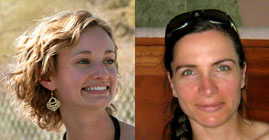

Tuesday - July 22, 2008
SLAC Today is available online at:
http://today.slac.stanford.edu
In this issue:
A New Editor for SLAC Today
Safety Today: Grass Fire Burns Close to SLAC Linac
P5 Report, HEP Roadmap Now Available
 |
 |
|
Tuesday - July 22, 2008 |
A New Editor for SLAC Today
Former SLAC Today Editor Kelen Tuttle (left) has become a full-time
writer in SLAC's Communications Office. Shawne Workman (right) has taken over
as editor of SLAC Today.
Shawne Workman has joined the SLAC communications group as the new editor for SLAC Today. Workman spent more than a decade in scientific writing and editing before taking up her new role, producing SLAC Today and working with science writing interns in the Communications Office. SLAC is familiar territory for Workman; she interned here in summer 2004, during a career hiatus in which she studied science writing at the University of California, Santa Cruz. "I spent that summer in awe and wonder, writing about science that's stranger than fiction and enjoying the bright and lively people here," she says. "It's fantastic to be back, and working on SLAC Today." She studied human biology and neuroscience before starting what she calls her first "real" job writing for a scientific software startup. Since then, she has worked as a technical and science writer and editor, covering topics ranging from pharmaceutical simulations to analytical chemistry methods. Most recently, she managed marketing publications for Dionex Corporation, a liquid chromatography company. Workman takes the reins from Kelen Tuttle, who came to SLAC in late 2005 to create and launch SLAC Today. Tuttle will now turn to writing full-time for SLAC, including for SLAC Today and symmetry magazine. "I feel really lucky," Workman says. "Kelen built a vibrant publication with a definite sense of community. It's fantastic to have such a great starting point, especially with Kelen still here providing advice, new stories, not to mention the back stories for all these acronyms." The Communications Office is extremely grateful to Kelen for consistently and tirelessly producing such a high-quality publication that the whole lab community has come to rely on and enjoy. We're sure that many of you will want to thank Kelen for her great work and welcome Shawne to the laboratory. |
||
|
|
||

Grass Fire Burns Close to SLAC Linac
Yesterday, in SLAC Today, we ran an article announcing controls to reduce the probability of fire due to this year's unusually high fire risk. As fate would have it, we were immediately reminded of this risk. Just before 1:00 p.m. on Monday, a very alert member of SLAC's Facilities Department saw smoke from a fire on Stanford's Jasper Ridge Biological Preserve on the south side of the Linac near Sector 14, and immediately called 911. Within a few minutes, responders from SLAC Environment, Safety and Health (ES&H), SLAC Security and fire department units from Palo Alto, Menlo Park, Woodside and Cal-Fire responded along with San Mateo County Sheriff's Department. Shortly thereafter, air attack units (a helicopter, two aerial tankers and a spotter plane) from Cal-Fire also flew over the fire, although they were not pressed into service. This outstanding reaction gave the responders an opportunity to quickly control the fire to less than one acre. Although smoke drifted over the Linac and the fire burned to the fence line, it never progressed onto SLAC property; there were no injuries and no damage to SLAC equipment. The cause is under investigation by fire officials. |
P5 Report, HEP Roadmap Now Available
In November 2007, the High Energy Physics Advisory Panel charged the Particle Physics Project Prioritization Panel to develop a 10-year plan for U.S. particle physics in each of four possible budget scenarios. In response, the 21-member subpanel, chaired by Yale professor Charlie Baltay, laid out strategies for the next decade that would allow the U.S. to maintain a leadership role in world-wide particle physics. The panel recommends a balanced program of research at three frontiers to address fundamental questions about the laws of the universe: the Energy Frontier, using both hadron colliders and lepton colliders to discover and illuminate the physics of the Terascale; the Intensity Frontier, comprising neutrino physics and high-sensitivity experiments on rare processes; and the Cosmic Frontier, probing the nature of dark matter and dark energy and other topics in particle astrophysics. The U.S. High Energy Physics Advisory Panel, a DOE and NSF advisory committee, endorsed the plan on May 29. Print copies of the report are available. To order a copy, e-mail Fermilab's Judy Treend at treend@fnal.gov. The report is also available online. |
Events
Access (see all)
Announcements
|
| | ||
|
|
||
 <%
Response.AddHeader "Last-modified", getArticleDate()
'Response.AddHeader "Last-modified","Mon, 01 Sep 1997 01:03:33 GMT"
'Monday, December 06, 2010
%>
<%
Response.AddHeader "Last-modified", getArticleDate()
'Response.AddHeader "Last-modified","Mon, 01 Sep 1997 01:03:33 GMT"
'Monday, December 06, 2010
%>View online at http://today.slac.stanford.edu/ |
||